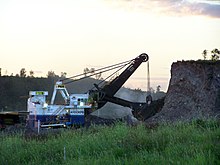Power shovel

Principle of rope-shovel operation.[1]
A power shovel (also stripping shovel or front shovel or electric mining shovel or Electric Rope Shovel [2]) is a bucket-equipped machine, usually electrically powered, used for digging and loading earth or fragmented rock and for mineral extraction.[3] Power Shovels are a type of rope/cable excavator, where the digging arm is controlled and powered by winches and steel ropes, rather than hydraulics like in the more common hydraulic excavators.
Basics parts of power shovel including the track system,cabin,cables,rack,
stick,boom foot-pin,saddle block,boom,boom point sheaves,and bucket.
The size of bucket varies from 0.375cu m to 5cu m.

P&H 4100 XPB cable loading shovel.
Contents
1 Design
2 Use
3 Operation
4 Giant Stripping Shovels
4.1 Notable Examples
5 See also
6 Further reading
7 References
Design
Shovels normally consist of a revolving deck with a power plant, driving and controlling mechanisms, usually a counterweight, and a front attachment, such as a crane ("boom") which supports a handle ("dipper" or "dipper stick") with a digger ("bucket") at the end. "Dipper" is also sometimes used to refer to the handle and digger combined. The machinery is mounted on a base platform with tracks or wheels.[4] Modern bucket capacities range from 8 m3 to nearly 80 m3.
Use

Shovel digging overburden.
Power shovels are used principally for excavation and removal of overburden in open-cut mining operations, though it may include loading of minerals, such as coal. They are the modern equivalent of steam shovels, and operate in a similar fashion.
Other uses of the power shovel are
1- Suitable for close range of work.
2- Capable of digging very hard materials.
3- Can remove big sized boulders.
4- To excavate the earth and to load the trucks.
5- It is used in various types of jobs such as digging in gravel banks,clay pits,digging cuts in road works,road-side berms,etc.
Operation
The shovel operates using several main motions:
- hoist - pulling the bucket up through the bank (i.e. the bank of material being dug)
- crowd - moving the dipper handle out or in to control the depth of cut and when positioning to dump
- swing - rotating the shovel between digging and dumping
- propel - moving the shovel unit to different locations or dig positions
A shovel's work cycle, or digging cycle, consists of four phases:
- digging
- swinging
- dumping
- returning
The digging phase consists of crowding the dipper into the bank, hoisting the dipper to fill it, then retracting the full dipper from the bank. The swinging phase occurs once the dipper is clear of the bank both vertically and horizontally. The operator controls the dipper through a planned swing path and dump height until it is suitably positioned over the haul unit (e.g. truck). Dumping involves opening the dipper door to dump the load, while maintaining the correct dump height. Returning is when the dipper swings back to the bank, and involves lowering the dipper into the track position to close the dipper door.
Giant Stripping Shovels

Big Brutus.
In the 1950s with the demand for coal at a peak high and more coal companies turning to the cheaper method of strip mining, excavator manufacturers started offering a new super class of power shovels, commonly called giant stripping shovels. Most were built between the 1950s and the 1970s. The world's first giant stripping shovel for the coal fields was the Marion 5760. Unofficially known to its crew and eastern Ohio residents alike as The Mountaineer,[5] it was erected in 1955/56 near Cadiz, Ohio off of Interstate I-70. Larger models followed the successful 5760, culminating in the mid 60s with the gigantic 15,000 ton Marion 6360, nicknamed The Captain.
Notable Examples
| Ranking | Bucket Capacity (m3/yd3) | Operating weight (tons)[6] | Type | Name | Service | Scrapped |
|---|---|---|---|---|---|---|
| 50/65 | 2,750 | Marion 5760 | The Mountaineer | 1956 | 1988 | |
| 138/180 | 15,000 | Marion 6360 | The Captain | 1965 | 1992 | |
| 107/140 | 9,350 | Bucyrus Erie 3850B | River King | 1964 | 1993 | |
| 99/130 | 6,850 | Bucyrus Erie 1950B | GEM of Egypt | 1967 | 1991 | |
| 96/125 | 9,338 | Marion 5960 | Big Digger | 1969 | 1989 | |
| 88/115 | 6,950 | Bucyrus Erie 3850B | The Big Hog | 1962 | 1985 (Accident) | |
| 80/105 | 7,200 | Bucyrus Erie 1950B | The Silver Spade | 1965 | 2007 | |
| 69/90 | 5,220 | Bucyrus-Erie 1850-B | Big Brutus | 1962 | Preserved as a National Landmark |
See also
- P&H Mining
- Bucyrus International
- Dragline
- Excavator
- Marion Power Shovel
- Steam shovel
Further reading
Extreme Mining Machines - Stripping shovels and walking draglines, by Keith Haddock, pub by MBI, .mw-parser-output cite.citation{font-style:inherit}.mw-parser-output .citation q{quotes:"""""""'""'"}.mw-parser-output .citation .cs1-lock-free a{background:url("//upload.wikimedia.org/wikipedia/commons/thumb/6/65/Lock-green.svg/9px-Lock-green.svg.png")no-repeat;background-position:right .1em center}.mw-parser-output .citation .cs1-lock-limited a,.mw-parser-output .citation .cs1-lock-registration a{background:url("//upload.wikimedia.org/wikipedia/commons/thumb/d/d6/Lock-gray-alt-2.svg/9px-Lock-gray-alt-2.svg.png")no-repeat;background-position:right .1em center}.mw-parser-output .citation .cs1-lock-subscription a{background:url("//upload.wikimedia.org/wikipedia/commons/thumb/a/aa/Lock-red-alt-2.svg/9px-Lock-red-alt-2.svg.png")no-repeat;background-position:right .1em center}.mw-parser-output .cs1-subscription,.mw-parser-output .cs1-registration{color:#555}.mw-parser-output .cs1-subscription span,.mw-parser-output .cs1-registration span{border-bottom:1px dotted;cursor:help}.mw-parser-output .cs1-ws-icon a{background:url("//upload.wikimedia.org/wikipedia/commons/thumb/4/4c/Wikisource-logo.svg/12px-Wikisource-logo.svg.png")no-repeat;background-position:right .1em center}.mw-parser-output code.cs1-code{color:inherit;background:inherit;border:inherit;padding:inherit}.mw-parser-output .cs1-hidden-error{display:none;font-size:100%}.mw-parser-output .cs1-visible-error{font-size:100%}.mw-parser-output .cs1-maint{display:none;color:#33aa33;margin-left:0.3em}.mw-parser-output .cs1-subscription,.mw-parser-output .cs1-registration,.mw-parser-output .cs1-format{font-size:95%}.mw-parser-output .cs1-kern-left,.mw-parser-output .cs1-kern-wl-left{padding-left:0.2em}.mw-parser-output .cs1-kern-right,.mw-parser-output .cs1-kern-wl-right{padding-right:0.2em}ISBN 0-7603-0918-3
References
^ Simionescu, P.A. (2014). Computer Aided Graphing and Simulation Tools for AutoCAD users (1st ed.). Boca Raton, FL: CRC Press. ISBN 978-1-4822-5290-3.
^ [1]
^ US Department of the Treasury, IRS: Appendix I - Glossary of Mining Terms
^ Encyclopædia Britannica, Power Shovel
^ "16 Tone Mobile Shovel Take 90 Ton Bite of Earth" Popular Mechanics, April 1956, p. 95.
^ Extreme Mining Machines, by Keith Haddock, pub by MBI,
ISBN 0-7603-0918-3